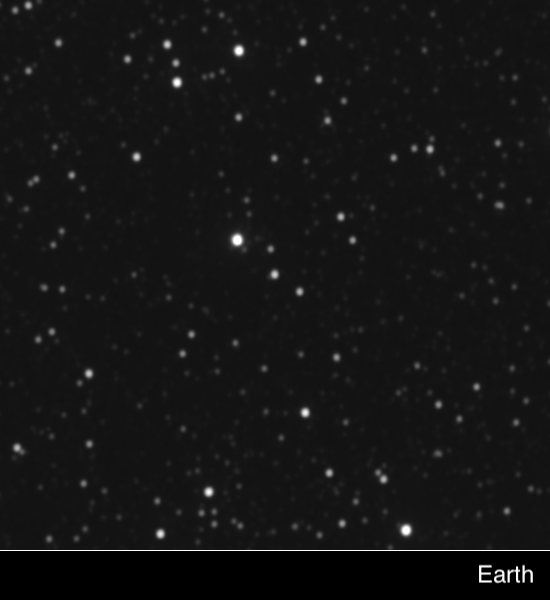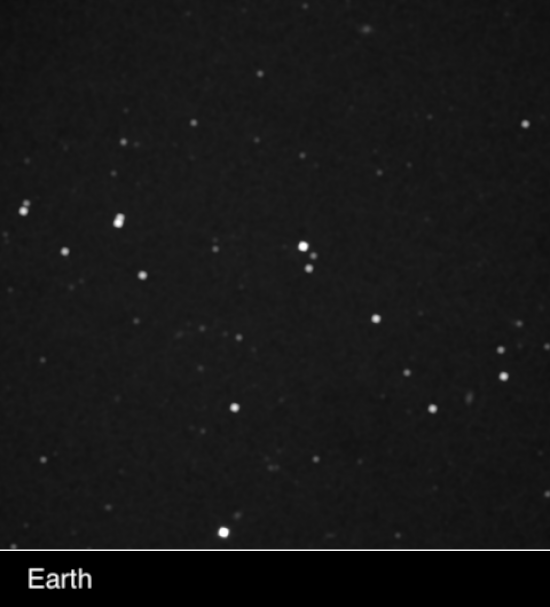“It’s fair to say that New Horizons is looking at an alien sky, unlike what we see from Earth.” Those are the words of Alan Stern (Southwest Research Institute), who is principal investigator for New Horizons. A breathtaking 7 billion kilometers from Earth, the spacecraft has just returned images showing the parallax effect for two nearby stars.
That ‘alien sky’ would look pretty much the same to the human eye except in the case of the closest stars, but the displacement of both Proxima Centauri and Wolf 359 against the deep space background is apparent in the images below. Proxima Centauri, the nearest star to our own, is shown in the top image, with Wolf 359 in the following one.


Image: This two-frame animation blinks back and forth between New Horizons and Earth images of each star, clearly illustrating the different view of the sky New Horizons has from its deep-space perch. Credit: NASA/Johns Hopkins Applied Physics Laboratory/Southwest Research Institute/Las Cumbres Observatory/Siding Spring Observatory.
This is stirring stuff. Taking parallax measurements of objects relatively nearby shows the kind of shift that first allowed astronomers to measure the distance to particular stars, beginning with 61 Cygni in 1838. That measurement was the work of Friedrich Bessel, whose attention had been drawn to the star by astronomer Giuseppe Piazzi, who had discovered its large proper motion compared to other stars. We now know that 61 Cygni has the 7th largest proper motion listed in the Hipparcos catalog, with Barnard’s Star and Kapteyn’s Star as numbers one and two.
Parallax studies like these have always involved looking at where a star is at one side of the Earth’s orbit and then at the other, but with the baseline given to us by New Horizons, we can detect the tiny shift not only with precise instrumentation but with the human eye as well. This is the largest parallax baseline ever, notes New Horizons science team member Tod Lauer (National Science Foundation), who coordinated the parallax demonstration, and who goes on to describe the images as “the first demonstration of an easily observable stellar parallax.”
But let me also quote Brian May, who often raises eyebrows when people realize that the rock guitar legend doubles as an astrophysicist and, I suspect, a science fiction fan. May worked with New Horizons deputy project scientist John Spencer (SwRI) to produce the striking images. Says May:
“It could be argued that in astro-stereoscopy — 3D images of astronomical objects – NASA’s New Horizons team already leads the field, having delivered astounding stereoscopic images of both Pluto and the remote Kuiper Belt object Arrokoth. But the latest New Horizons stereoscopic experiment breaks all records. These photographs of Proxima Centauri and Wolf 359 – stars that are well-known to amateur astronomers and science fiction aficionados alike — employ the largest distance between viewpoints ever achieved in 180 years of stereoscopy!”
I’m a great enthusiast for robotic telescope installations like the one at Las Cumbres Observatory at Siding Spring Observatory in Australia and Mt. Lemmon Observatory in Arizona, both of which were used to acquire Earth-based images of Proxima Centauri and Wolf 359, but to have the concept extended to a spacecraft at this distance from Earth is a bit mind-boggling. New Horizons needed, at the time of these observations, almost six hours and thirty minutes to get a signal home, and it will eventually exit the Solar System entirely, like both our Voyagers. An indication of the distances involved is provided by the fact that in the Proxima Centauri image, the second closest star is 120 times more distant than Proxima itself.
You’ll recall that the New Horizons team put out a call for amateur astronomers to send matching images of the two stars taken on April 22 and 23rd, with timing adjusted to the fact that New Horizons was almost three light hours closer to Proxima Centauri than Earth (and almost four light hours farther from Wolf 359) when the images were taken. You can use the hashtag #NHparallax for more, or visit this New Horizons page, where images can be downloaded in FITS format, commonly used by astronomers to preserve image fidelity while including technical data about the image, as well as readily readable 16-bit PNG format.



A baseline of 6+ light hours implies the equivalent of an interpupillary distance of the same magnitude. With the brain midway between the two extremes the time for travel from each pupil would be 3+ hours. In other words from pupil to perception would be 3+ hours.
The depiction of travel through the galaxy and beyond shows a passing of objects, which through their differing apparent motion impart a sense of motion of the observer. This motion, particularly the passing of stars so quickly, would imply faster-than-light travel.
So this is a demonstration of a shift easily detectable to the human eye–but presumably, objects that are further away still, and whose shift would not be human-detectable, will also be shifted by a tiny amount that will be machine-detectable. My question is: can New Horizons’ current baseline with Earth and the resolving power of its camera, in conjunction with earth-bound telescopes, improve any currently uncertain distance measurements? Or are all objects whose distance is not known to great accuracy so far away that even New Horizons’ parallax is of no use in helping with the question?
(I know that for very distant objects other methods (apparent brightness/spectral luminosity) are the only helpful ones. But maybe there are some in-betweeners whose distance New Horizons can help to pin down?)
Why does Proxima look like it is being partially eclipsed in the New Horizons image? Any remote chance that it WAS being eclipsed???
(The none existing) Planet 9? ?
“New Horizons was almost three light hours closer to Proxima Centauri than Earth (and almost four light hours farther from Wolf 359) …”
so New Horizons is moving closer to Proxima Centauri and further from Wolf 359? New Horizons is moving in a southerly direction out of the ecliptic ?
In about 7 years, Voyager 1 will reach 1 light Day: our first spacecraft to reach that milestone.
Have the images yielded any extra significant figures in the distance estimates?
Read the second comment (Frank Reed) on this earlier article, and related follow up comments by others:
https://centauri-dreams.org/2020/04/19/new-horizons-parallax-program-gears-up/
Is the information about the magnignitude of the shift in arcsec available somewhere? I couldn’t find it in any picture that ws published online in these days…
Dear Fabio,
The 2020 RASC Handbook lists the parallaxes for Proxima Centauri and Wolf 359 as 769 and 414 milliarcseconds respectively, but this is based on a baseline of 1 AU. You would have to multiply these values by the number of AU the spacecraft was from earth at the time the spacecraft images were made to determine the value of the shift. You would also have to take into account where the earth was in its orbit when the earth images were made. Pluto’s mean distance from the sun is 39.3 AU, but in 2019 it was 33.84 AU. Those are the only two figures available in the Handbook. I hope that helps.
My back-of-the-cocktail-napkin estimate puts the shifts at about 26″ (Proxima) and 14″ (Wolf 359) approximately, assuming the spacecraft was 34 AU from earth.
Does anyone know this has been done with two dim red dwarfs instead of (or as well as) Alpha Centauri A and B ?
In partial response to jonW’s comment above
New Horizons has beautifully demonstrated the feasibility of Very Long Baseline parallax measurements by spacecraft. A probe in a comparable orbit with sensors optimized for astrometry could provide exceedingly valuable measurements for determining distances and proper motions. These fundamental measurements are the foundation of all distance estimates in astronomy, from nearby stars to the most distant galaxies, and to the kinematic behavior of our own Milky Way. Trigonometric parallaxes are assumption and bias free. they are direct measurements that require no additional speculation or estimates, and whose uncertainties can be determined with statistical precision.
Historically, every advance in trigonometric parallax technology has cascaded ‘up the line’ to improved distance estimates–all the way out to the realm of the nebulae. In these days of glamorous relativistic cosmology and sexy high-energy astrophysics, this sort of basic survey work is often neglected, although almost all our other work depends on it .
I submit that a dedicated VLB astrometry mission, especially one capable of long term operation at the edge of the solar system (nuclear powered?) would provide unexpected benefits for all of astronomy, and I encourage anyone of any influence in planning these missions who might be reading this give this type research as much support and publicity as possible. The advantages provided by very long baselines cannot be replaced by mere technological sophistication. It improves on the geometry itself.
I cannot stress too much that this is not just a novel clever application, this has the potential for extremely variable research that could benefit many different astronomical applications. We need to follow up on it.
Indeed. Dedicated VLB astrometry mission(s) should be high on the list for deep space exploration. Imagine what could be learned with two of such probes sent out in opposite directions!
Voyager Spacecraft Detect an Increase in The Density of Space Outside The Solar System
MICHELLE STARR
19 OCTOBER 2020
In November 2018, after an epic, 41-year voyage, Voyager 2 finally crossed the boundary that marked the limit of the Sun’s influence and entered interstellar space. But the little probe’s mission isn’t done yet – it’s now sending home information about the space beyond the Solar System.
And it’s revealing something surprising. As Voyager 2 moves farther and farther from the Sun, the density of space is increasing.
It’s not the first time this density increase has been detected. Voyager 1, which entered interstellar space in 2012, detected a similar density gradient at a separate location.
Voyager 2’s new data show that not only was Voyager 1’s detection legit, but that the increase in density may be a large-scale feature of the very local interstellar medium (VLIM).
The Solar System’s edge can be defined by a few different boundaries, but the one crossed by the Voyager probes is known as the heliopause, and it’s defined by the solar wind.
This is a constant supersonic wind of ionised plasma that streams out from the Sun in all directions, and the heliopause is the point at which the outward pressure of that wind is no longer strong enough to push into the wind from interstellar space.
Full article here:
http://www.sciencealert.com/for-some-reason-the-density-of-space-is-higher-just-outside-the-solar-system/amp